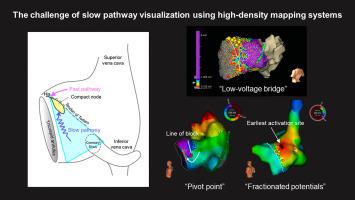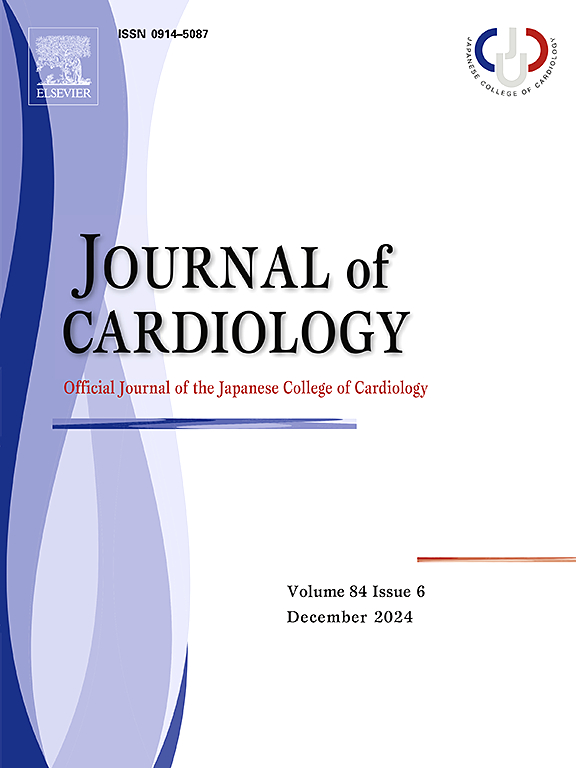镜头之外:在高密度绘图时代揭开看不见的房室结的面纱。
IF 2.5
3区 医学
Q2 CARDIAC & CARDIOVASCULAR SYSTEMS
引用次数: 0
摘要
许多研究已经阐明了房室结周围区域(通常称为科赫三角区(ToK))的组织学特征。虽然有研究认为,电脉冲从心房经房室结传导至心室的过程涉及具有不同传导特性和间隙连接蛋白的心肌细胞,但对这种复杂传导的全面了解尚未完全建立。此外,虽然房室结性返流性心动过速(AVNRT)的顺行和逆行传导有多种途径,但房室结性返流性心动过速的返流回路尚未完全阐明。因此,针对房室结再发性心动过速的慢通路消融术一直以来都是针对其解剖位置和窦性心律时获得的慢通路电位进行的。最近,高密度三维(3D)绘图系统的进步促进了对 ToK 内更详细电生理电位的采集。多项研究表明,窦性心律时获得的 ToK 内的激活模式、低电压区以及心动过速时获得的分馏电位可能是慢通路消融的最佳目标。本综述概述了迄今为止所报道的房室结周围组织,并总结了目前对房室传导和房室NRT回路的理解。此外,我们还讨论了利用高密度三维绘图系统进行慢通路消融的最新发现,并探讨了最佳慢通路消融策略。本文章由计算机程序翻译,如有差异,请以英文原文为准。


Beyond the lens: Unveiling the invisible atrioventricular node in the era of high-density mapping
Numerous studies have clarified the histological characteristics of the area surrounding the atrioventricular (AV) node, commonly referred to as the triangle of Koch (ToK). Although it is suggested that the conduction of electric impulses from the atria to the ventricles via the AV node involves myocytes possessing distinct conduction properties and gap junction proteins, a comprehensive understanding of this complex conduction has not been fully established. Moreover, although various pathways have been proposed for both anterograde and retrograde conduction during atrioventricular nodal reentrant tachycardia (AVNRT), the reentrant circuits of AVNRT are not fully elucidated. Therefore, the slow pathway ablation for AVNRT has been conventionally performed, targeting both its anatomical location and slow pathway potential obtained during sinus rhythm. Recently, advancements in high-density three-dimensional (3D) mapping systems have facilitated the acquisition of more detailed electrophysiological potentials within the ToK. Several studies have indicated that the activation pattern, the low-voltage area within the ToK obtained during sinus rhythm, and the fractionated potentials acquired during tachycardia may be optimal targets for slow pathway ablation. This review provides an overview of the tissue surrounding the AV node as reported to date and summarizes the current understanding of AV conduction and AVNRT circuits. Furthermore, we discuss recent findings on slow pathway ablation utilizing high-density 3D mapping systems, exploring strategies for optimal slow pathway ablation.
求助全文
通过发布文献求助,成功后即可免费获取论文全文。
去求助
来源期刊

Journal of cardiology
CARDIAC & CARDIOVASCULAR SYSTEMS-
CiteScore
4.90
自引率
8.00%
发文量
202
审稿时长
29 days
期刊介绍:
The official journal of the Japanese College of Cardiology is an international, English language, peer-reviewed journal publishing the latest findings in cardiovascular medicine. Journal of Cardiology (JC) aims to publish the highest-quality material covering original basic and clinical research on all aspects of cardiovascular disease. Topics covered include ischemic heart disease, cardiomyopathy, valvular heart disease, vascular disease, hypertension, arrhythmia, congenital heart disease, pharmacological and non-pharmacological treatment, new diagnostic techniques, and cardiovascular imaging. JC also publishes a selection of review articles, clinical trials, short communications, and important messages and letters to the editor.
 求助内容:
求助内容: 应助结果提醒方式:
应助结果提醒方式:


